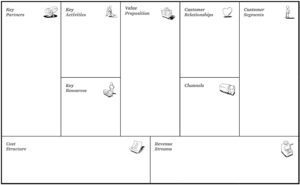In the Business Model Canvas, the Value Proposition and Customer Segment come together to define the Product – Market fit of your business. Everything else in the Canvas feeds off of these two things.
Whether you start with a known Customer segment or a Value Proposition really doesn’t matter because you actually can’t have one without the other. They are presented separately mainly so that you can do a deeper dive of each side of this two sided coins.
If you have multiple Customer Segments, then you need a Value Proposition for each one. The value that you provide might be prioritized differently for different markets.
Start with the customer
Value Proposition statements must start with “For Customer Segment X”, and then detail what problem they have or job they need you to do, the solution you offering them, and why this is important to them.
When breaking it down like this than only one of the pieces in the statement is about our business – the rest is all about the customer. Kinda like we have two ears and only one mouth, so that we can listen more than talk. What is the problem we are solving for them and why is it important to them is the key part of the value statement. How you provide this is in truth incidental – and can be changed as technology changes or your understanding of the problem or value increases.
It doesn’t have to be written for everyone – just every customer
The reason writing the Value Proposition in terms of the benefits to customer is gets stressed so much is because most products do start as the idea or creation of an expert, and experts find this task of defining their creation outside of their expertise to be very difficult.
As SMEs or ideas people, we are so excited about delivering our features or advancement that we forget that the customer might not really care about detailed specifications. But they do care that the solution will make their life/job easier, save them money, save them time, and eliminate the problems they are having.
Sometimes when we are delivering something very technically specific, there is a need to still present information in a language of that expertise to address the concerns of the technical influencers in the buying process. The point is that this should be in addition to the value it offers, rather than be limited by it.
There needs to be a specific Value Proposition for each customer segment. Each subsequent box in the Canvas needs to focus on how it relates to that Product-Market fit. Potentially leading to a separate Canvas if the market segments are so different they require different solutions.
To provide us with flexibility to grow or change our solution
If we focus on the value of we are providing customers than we have room to change or grow our solution as technical advances in our industries come about. A bit of an additional twist on why we should not be focused on features firstly.
I can’t help but think of the PC race of the last number of decades as a great example of this. For almost 20 years, PC manufacturers came out annually with new versions of their products with faster CPUs, more storage, larger internal discs and better graphics cards.
Though there were a lot of contributors to why PC sales fell off in the late 2000s, I don’t think it’s co-incidental that this coincided with the advent of smarter smart phones and tablet devices. I think if the manufacturers of these products focused more on the value statements of ease of use, portability and the applications you could use on it, rather than trying to outdo with bigger stronger specs, there may have been a different story. Or maybe, the MS Surface tablet would have been built sooner and garnered a larger market share in the tablet market.
If we are focused on our customer’s problems and what value we can provide them, then we can constantly review if our solution is still meeting this as time goes on or do we need changes and improvements.

